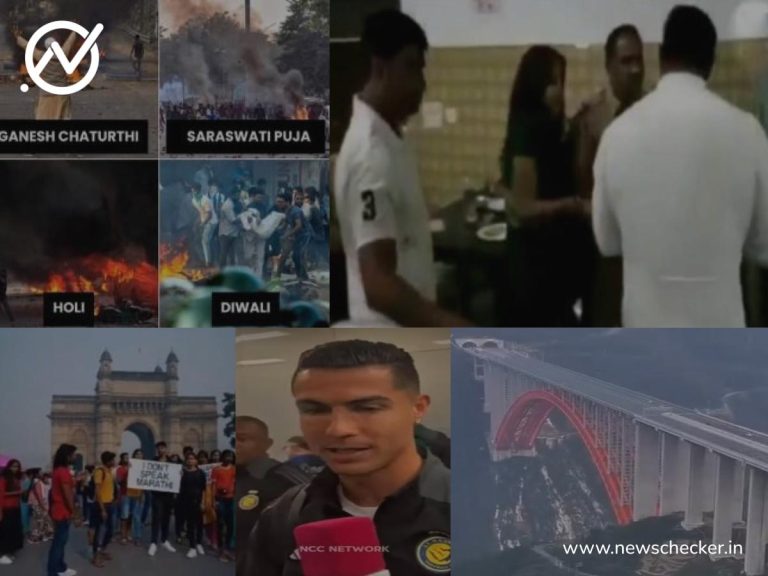The Rise of Misinformation: A Deep Dive into Recent Fact-Checks
In today’s digital age, the rapid spread of misinformation poses a significant threat to informed public discourse and societal harmony. This week’s collection of fact-checks highlights the diverse and insidious nature of false narratives circulating online, ranging from manipulated videos to misleading images and outright fabricated stories. The ease with which misinformation can be created and disseminated requires constant vigilance and critical thinking from news consumers. These examples underscore the importance of reputable fact-checking organizations in debunking false claims and promoting accurate information.
Communal Violence and Political Manipulation in West Bengal
Recent communal violence in West Bengal has become a breeding ground for misinformation, with political actors actively contributing to the spread of false narratives. The West Bengal BJP shared a photo collage purporting to show Muslim unrest during Hindu festivals, attempting to paint a picture of targeted violence against the Hindu community. Fact-checkers, however, revealed that the images were either misrepresented or taken out of context, exposing a deliberate attempt to inflame communal tensions. This incident demonstrates how sensitive events can be exploited for political gain through the dissemination of misinformation. Such tactics not only deepen existing societal divides but also undermine efforts to promote peace and understanding.
Another instance involves a video falsely claiming to show a West Bengal MLA assaulting a police officer. The video, in reality, depicted a BJP councillor from Uttar Pradesh engaging in the violent act. This case highlights the dangers of repurposing old videos and attaching them to unrelated current events to create a false narrative. The speed at which such misinformation spreads online underscores the need for quick and effective fact-checking to prevent it from taking hold in the public consciousness.
Manipulated Media: From AI-Generated Videos to Misleading Footage
Beyond the political realm, misinformation also manifests in manipulated media, both through sophisticated technologies like Artificial Intelligence (AI) and through simpler methods like misrepresenting existing footage. A video circulating online claimed to show the Delhi-Srinagar stretch of National Highway 44, featuring an impressive arch bridge in a mountainous terrain. Fact-checkers, however, revealed the footage to be from China, demonstrating how easily geographically unrelated content can be misrepresented to create a false impression. This example highlights the importance of verifying the source and context of any video or image before accepting it as genuine.
The increasing accessibility of AI technology has further complicated the fight against misinformation. AI-generated videos are becoming increasingly realistic, making it more challenging to distinguish between authentic footage and fabricated content. A viral video purportedly showing a massive protest against Marathi imposition in Mumbai was debunked as an AI creation. This case underscores the potential for AI to be misused for spreading propaganda and manipulating public opinion. As AI technology continues to advance, the need for sophisticated detection tools and media literacy education becomes even more critical.
Even globally recognized figures like Cristiano Ronaldo are not immune to the manipulations of AI. A video allegedly showing the football star expressing support for Palestine was debunked as a fabrication, created using AI voice cloning technology. This incident exposes the potential for AI to be used to create deepfakes that can damage reputations and spread misinformation on a global scale. The implications of this technology are far-reaching, and it underscores the need for robust safeguards to prevent its misuse.
The Urgent Need for Media Literacy and Critical Thinking
The proliferation of misinformation underscores the urgent need for enhanced media literacy and critical thinking skills among citizens. Individuals must be equipped to discern between credible and unreliable sources, to question the information they encounter online, and to verify the authenticity of content before sharing it. Educational institutions, media organizations, and government agencies all have a role to play in promoting media literacy and empowering citizens to navigate the complex digital landscape.
In conclusion, the recent spate of fact-checks highlights the multifaceted nature of misinformation and the ease with which it can spread in the digital age. From politically motivated manipulation to the use of advanced AI technology, the tactics used to create and disseminate false narratives are constantly evolving. Combating this growing threat requires a multi-pronged approach, including robust fact-checking, technological solutions to detect manipulated media, and most importantly, empowering individuals with the critical thinking skills necessary to identify and reject misinformation. The future of informed democratic discourse hinges on our collective ability to navigate the complexities of the digital age and prioritize truth over falsehood.


